Crown Works - Davies
Brothers |
|
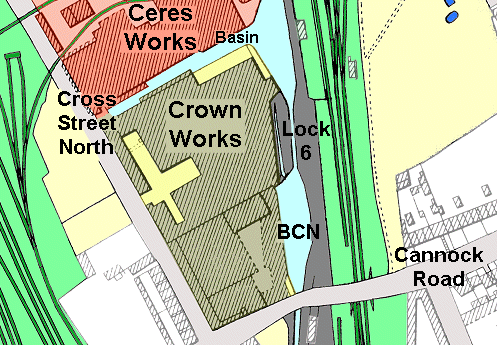
The location of Crown
Works. |
The business was founded in
1838 by Edward Davies to galvanise iron and
ironwork, with premises on Snow Hill.
Edward Davies
is credited with introducing galvanising to the
town. In fact the firm was one of the first hot dip
galvanising companies in the world.
The entry in
White’s 1851 Staffordshire Directory is as follows:
Edward Davies, iron and tin
plate worker, zinc etc., Snow Hill. |
| The firm was very successful
and moved to a larger site in 1869, between Cross
Street North and the BCN, covering approximately 3½
acres.
On the site they built a new factory called Crown
Works, next to Ceres Works, with a wharf on the
southern side of an existing basin.
There was also a second narrower basin just south
of Lock 6. |
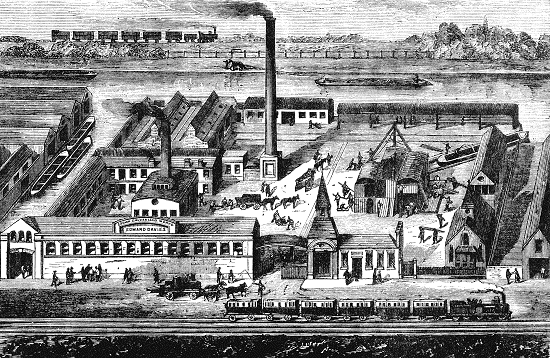
Crown Works in 1872. From
Griffith's Guide to the Iron Trade of Great Britain. |
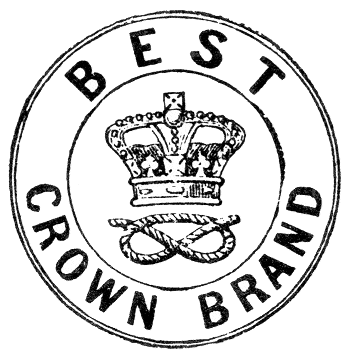 |
The factory entrance was situated in Cross
Street North, even though the site extended
southwards to the Cannock Road. When the factories were in
operation the whole area must have filled with
unpleasant acrid smells from galvanising, and an
equally unpleasant smell from Ceres manure works,
and the Corporation’s sewage works in Crown Street.
Most of their products carried the "Crown and
Knot" trademark, the crown being a symbol almost
universally used to denote the quality of iron and
the knot being the Staffordshire knot.
For other products they used the brand name "Nonsuch".
|
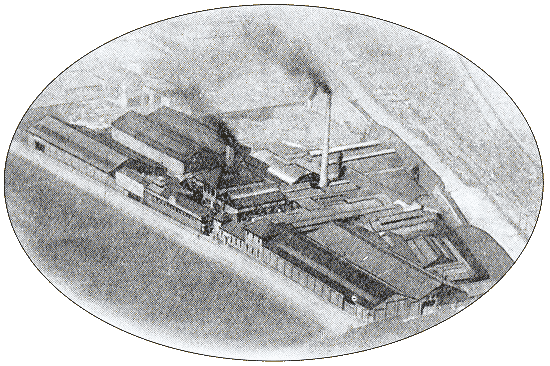
Crown Works in 1924.
|
The business is described in
Samuel Griffith’s “Guide to the Iron Trade of Great
Britain” published in 1873, as follows:
We believe Mr. Davies was the
first to introduce galvanising on a large scale to
Wolverhampton, in 1838. The trade has since become
one of the principal staple trades of the town.
Nevertheless, Mr. Davies’s article has always kept a
very high position in the market. The brand of the
Crown Works is a crown surmounting the Staffordshire
knot.
His best Crown Sheets have
always been well known and appreciated in the
market, and occupy the very highest position in the
United States of America and Australia.
Mr.
Davies likewise galvanises best, and high class
charcoal sheets. Iron is also tinned for various
purposes. Galvanised iron houses for export are made
largely at Mr. Davies’s factory, which is well
situated for railway and canal accommodation.
|
|

An advert from 1924. |
The iron houses referred to in
Griffith’s description were built with galvanised
corrugated iron sheets.
The firm made huts and
shelters which grew in size until houses, halls,
churches, and other sizeable buildings were made,
and exported all over the world. This part of the
business grew into the Constructional Department.
Edward Davies retired in the
mid 1870s and his two sons Edward Albert Davies and
James Davies took over the business, which became
known as Davies Brothers & Company.
In 1884 the
partnership was dissolved when James left to start
his own business.
On 7th March, 1885 a
new company, Davies Brothers & Company Limited was
formed with a capital of £100,000 in 1,000 shares of
£100 each.
The new company purchased the premises,
machinery, stock, and goodwill from Davies Brothers
& Company. |
| Edward Albert Davies became
Managing Director, and Moses Bayliss became
Chairman. He was a past chairman of Bayliss, Jones
and Bayliss.
Also on the board were his nephew
William Maddock Bayliss, the then present chairman
of Bayliss, Jones and Bayliss, and his son William
Maddock Bayliss, who became chairman of Davies
Brothers in 1895 after the death of his father. The
Company Secretary was James Saunders.
William was
one of the leading authorities on physiology and
became Professor of General Physiology at University
College London in 1912. He was knighted in 1922 for
his physiological work. |
|
Although the company had
extensive canal wharfage, products were also sent by
rail. In the 1885 minute book, guaranteed payments
are listed to the Midland Railway, the Great Western
Railway, and the BCN.
The new company got off to a
bad start, finding it difficult to compete with
other manufacturers of galvanised sheet iron. The
directors even considered moving to South Wales to
produce steel in order to manufacture galvanised
sheet steel.
The situation greatly improved
when the company patented a method of automatically
galvanising sheets of iron or steel, which could
also be corrugated as part of the process. This was
the first process of its kind in the world.
Patents
were taken out in 7 countries, and manufacturers
paid royalties to Davies Brothers for using their
system, which became very popular in the USA.
The
company was awarded a gold medal for the
breakthrough at the 1893 Chicago World Trade Fair.
As a result the company became very profitable.
|
 |
| View some products from
the company's 1910 catalogue |
 |
|

An invoice from 1912. |
In the 20th century
corrugated sheet roofing, and galvanised corrugated
sheets became successful products which were
exported to many countries.
The company’s tank and
cistern making department became very successful,
and produced a wide variety of riveted or welded
galvanised tanks, cisterns, and hot water tanks for
domestic installations.
Other products included
water barrows, feeding troughs, drinking troughs,
buckets and tubs, sanitary vessels of all kinds,
gutters, and downpipes.
|
| Davies Brothers also began to
produce none-galvanised products. The Constructional
Department began to manufacture steel framed
buildings that were cladded with asbestos cement
sheets.
Some of the tanks for storing liquids, such
as oil and petrol, were too large to be galvanised. |
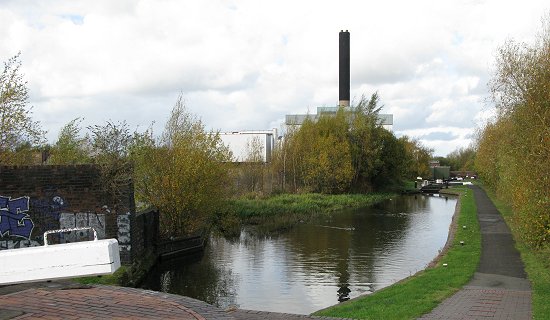
The site of Crown Works, as
seen from lock 6. |
|
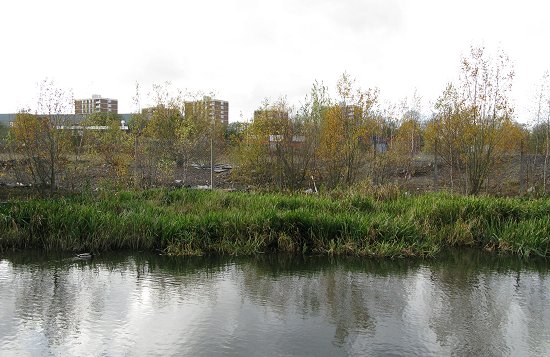
The derelict site of the
factory in 2009. |
The canal basins were still in
use in the early 1930s when the acid used in the
works was conveyed by narrow boat from Oldbury by
Thomas Clayton, and coke was conveyed from Stafford
Road Gas Works by George and Mathews. The waste acid
was also transported by canal, on Fellows, Morton
and Clayton boats to Courtaulds in Horton Road. The
same company transported the galvanised sheets for
export to Ellesmere Port.
|
| After the Second World War
sales started to decline.
In 1946 Peter Davies the
great grandson of the founder, Edward Davies joined
the management team.
He was the last member of the
Davies family to work for the company. He left in
1964. |
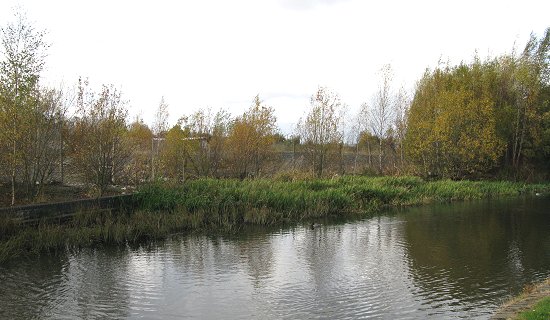
The site of the large basin. |

|
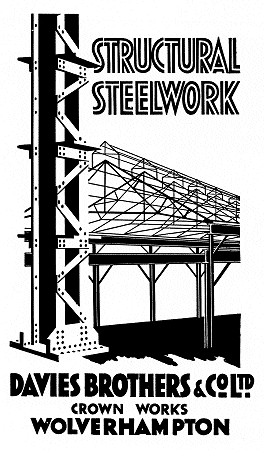
An advert from 1935. |
The company’s entry in the 1949
Wolverhampton Handbook is as follows:
Davies Brothers & Company
Limited, Crown Works, Wolverhampton. Manufacturers
of riveted or welded tanks for storage of water,
petrol, or fuel oil, galvanised cisterns, cylinders
and hot water tanks for domestic hot water supply,
galvanised gutters and downpipes, galvanised cattle
troughs, garden and water barrows, steel hay barns,
roofs and buildings.
In 1963 the company acquired
Gittins and Mellor Limited to replace the
Constructional Department which closed. Gittins and
Mellor shared the factory and the offices with the
parent company, and manufactured ‘Liteway’ steel
flooring, tubular steel handrailing, and
constructional steelwork.
|
|
The Davies Brothers letterhead
from 1978 lists the following products:
Oil tanks, petrol tanks,
galvanised cisterns, cylinders, tanks and cattle
troughs, corrugated cisterns, galvanised feeding
appliances, swing water barrows, coal bunkers,
street bins, water cart bodies, pipes and hoppers,
galvanised sinks, steel platework, open-type steel
flooring, handrailing, handrail standards,
structural steelwork.
The company closed in 1981 and
the factory became a scrap yard.
The site was
acquired by Wolverhampton Council in 1993.
The
factory has since been demolished and the area
cleaned of toxic substances.
It has been used as a
car park, but is now derelict. |
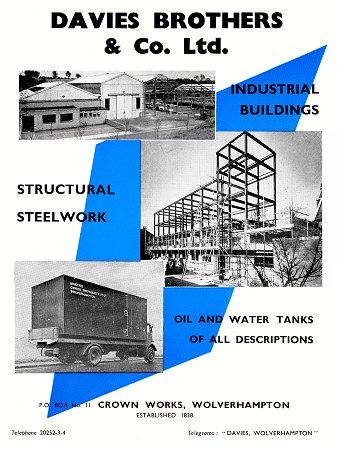
An advert from 1965. |
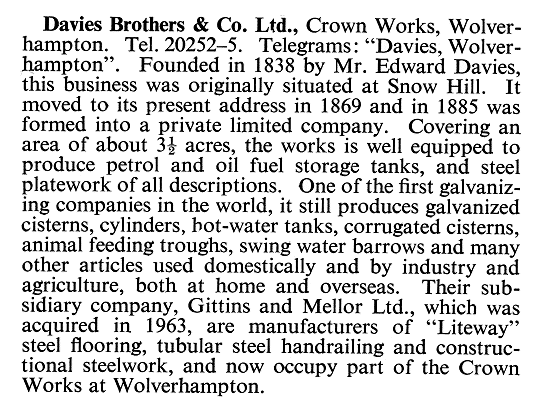
From the 1965 Wolverhampton Handbook.
 |
|
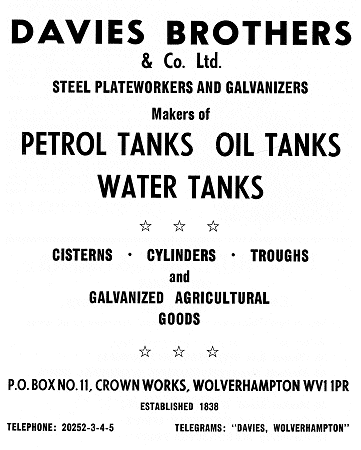 |
|
An advert from 1970. |
|
An advert from 1972. |
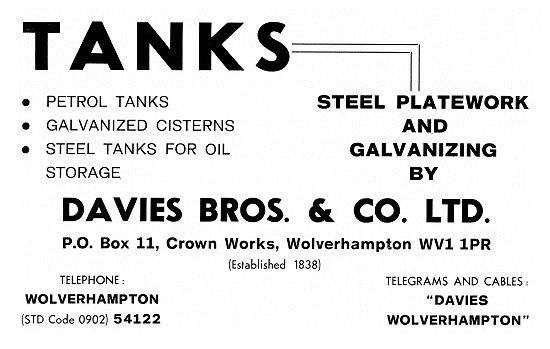 |
An advert from 1974. |
| From the 1974
Wolverhampton Handbook. |
 |
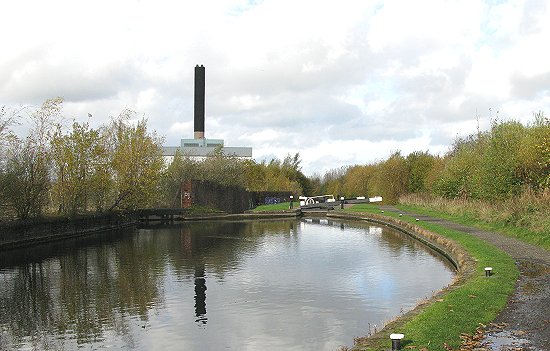
A final view from the canal looking
towards lock 7.
 |
|
Return to the general metalware section |
|